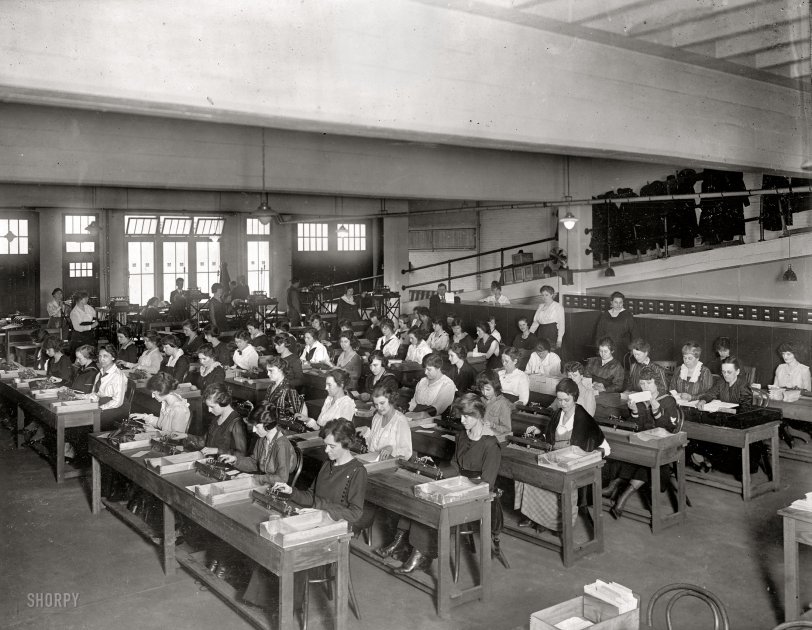


Framed or unframed, desk size to sofa size, printed by us in Arizona and Alabama since 2007. Explore now.
Shorpy is funded by you. Patreon contributors get an ad-free experience.
Learn more.

- Details, Details
- What's that building to the left of the tower?
- Coal Barges
- Bromo-Seltzer
- Inner harbor
- The Basin
- What a headache!
- Giant stepladder?
- Baldwin 62303
- Baldwin VO-1000
- Cold
- No expense spared
- Tough Guys
- Lost in Toyland
- And without gloves
- If I were a blindfolded time traveler
- Smoke Consumer Also Cooks
- Oh that stove!
- Possibly still there?
- What?!?
- $100 Reward
- Freeze Frame
- Texas Flyer wanted
- Just a Year Too Soon
- WWII -- Replacing men with women at the railroad crossing.
- Yes, Icing
- You kids drive me nuts!
- NOT An Easy Job
- I wonder
- Just add window boxes
Print Emporium
The Tabulators: 1920

Washington, D.C., circa 1920. One of half a dozen images labeled "Tabulating Machine Co." Harris & Ewing Collection glass negative. View full size.
P&V
Likely two operations going on here - punching and then verifying. When I worked in an IBM environment in the sixties we had a room with a lot fewer ladies who did exactly that - punch and verify.
Data entry
The ladies are not doing computing, they are doing data entry. They are using an early version of an IBM keypunch (numerics only). The lady at the near end of the fourth row is checking her work.
Card punches
These machines are 10-key card punches of the old style as shown on this page (scroll to the center).
They're not adding machines!
These are card punch machines, not adding machines. Adding machines of this time period had a lot more mechanical stuff to them. These machines just punch holes in the Hollerith cards. The machinery at the back of the room does all the adding up work.
The adding machine
You know, the movie with Phyllis Diller? I wonder which one is going to lose it... My guess is the one in the front row looking straight into the camera.
Bathroom break
Rows A through F first, ten minutes please
CPM
Hahaha!! Loved the CPU architecture reference. I seriously wonder, how many cycles per second (Hertz) or IPS a human cluster like this would do as a whole. Did they measure efficiency by calculations per minute, as in words per minute for typists?
Tabulating Machine Co
Herman Hollerith founded the Tabulating Machine Co. in 1896 in Georgetown. The building still stands, with a commemorative plaque. In 1924 it merged with three other companies to become IBM.
Computers
Until the 1960's and the advent of the electronic calculator, groups of women like this -- it was a women's occupation -- performed calculations on mechanical calculators. The women were, in fact, called computers.
Punch cards
Herman Hollerith introduced tabulating machines and punched card tabulating systems to the census in 1890 and they were used through at least 1940. Later known as IBM cards.
One or Two
I'm sitting here and can't believe my lying eyes. One or two of these gals are not heinous. I better take a break, and look again.
I know nothing
about tabulators versus computers, but, as with most of these early office photos, the men in this one seem to be standing around looking good while the women work their nimble fingers to the bone. All that is missing is a whip and a chair! Thank goodness, they've come a long way, baby.
Drive-in office?
Am I imagining things, or is this office space a converted parking garage? I love the hat and coat storage up on the ramp!
Chinatown - San Francisco
Although we may look at this group and declare them "obsolete", I was in S.F. last summer and made some purchases in Chinatown. Without exception, each purchase was figured out on an abacus. These comptometers or adding machines are actually based on that device as the abacus is the forerunner of these machines. Everything old is new again.
Tabulators
In 1920, I believe those people would have been called - Computers.
Seriously.
CPU architecture
Looks like they have a register file of seven 8-bit registers - the last 2 rows are the stack register (with extra parity bits) and status register. The I-cache operators are standing by in the back to the left, while the 2 D-cache operators are standing in the back to the right (with there kilobytes of storage). Looks like there are a few bad bits (staring at the camera) that will cause a timing violation. Where's the boundary scan?
























On Shorpy:
Today’s Top 5